A basket of valentines to our four lovely ladies in this blog. Through the mists of long-ago years, I retrieved the names of Chief Smallwood’s daughters: Mary Jane, Lorinda, Amelia, and Elmira. All except the youngest daughter, Elmira, were born before the Civil War in the old Kiamitia County.
Chief Smallwood married his second wife, Annie Burney, in 1849, after his first wife Sinai LeFlore died. Annie was a Chickasaw Indian woman, of the house of Ima-te-po and family of Okla-pa-nubbii. She died in 1863 during the Civil War.
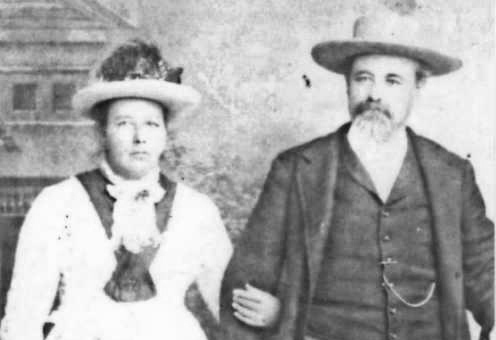
Benjamin Smallwood opened a mercantile store in Kiamichi County in 1862 but in the following year moved west to the vicinity of Lehigh where he built up his cattle business and enlarged his store. The governor later married a third time about 1865, to Mary Abigail James (a daughter of Benjamin and Mary James). She helped to raise his young daughters, but there were no more children.
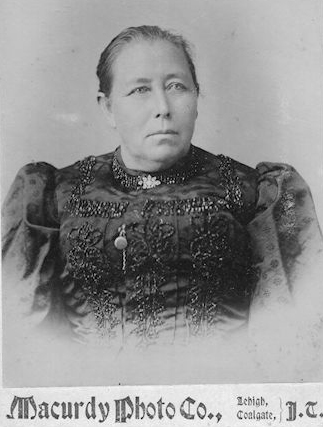
When he left office, Chief Smallwood retired to his farm west of Lehigh in what is today Coal County, Oklahoma where he passed away on December 15, 1891. His third wife in 1892 became the wife of the National Attorney Charles Stewart Vinson also a resident of Lehigh, I.T.
As well as a son Michael, Chief Smallwood and Annie Burney had four daughters:
- Lorinda, called ‘Sis’, 1849-1877, wife of H.C. James
- Mary Jane, abt. 1856-1879, wife of Thomas L. Griggs
- Amelia 1858-1920, wife of John Frinzel
- Elmira 1862-1887, wife of Harry Cox
Lorinda ‘Sis’ Smallwood James
In 1868 Miss Lorinda married a man of her Lehigh community, the well-respected rancher Henry Clay James. He was born on January 8, 1840 in the Choctaw Nation to a white man, Benjamin James, and a Choctaw woman named Mary Ann.
There is much speculation about who Benjamin James was. One of the signors of the Treaty of Dancing Rabbit was a Benjamin James (a translator for the Choctaws), who received two sections of land. Benjamin James, Jr. is listed as living next to Capt. Benjamin James on the Armstrong Roll and is thought to be a son. A Last Will and Testament for Benjamin James of the Choctaw Nation, dated Apr 25, 1859, acknowledges a son, Henry, among other children. Executors named in the will were George W. Harkins, John Carr, and Leroy P. Griggs.
In testimony before the Dawes Commission on Dec 8, 1903 [Census Card #42], Henry C. James stated that he was sixty years old living near Lehigh, I.T. He was a citizen by birth of the Choctaw Nation. He was born in Boktuklo County, C.N., close to Lukfata in the vicinity of Wheelock Academy. For the past 13 years he resided about 2 and a half miles west of Lehigh.
What Mr. James did not say was that he and his wife were stalwarts of the community, helping it to grow and prosper. We have to read between the lines of his wife Lorinda’s obit to find their value to the community.
Among their children was Mrs. Amy Annie Hawkins, a great historian of her times. He son Lee F. Harkins took up the mantle as printer and the publisher of the American Indian magazine for several years.
Her son William C. James lived in the Olney community where he and his wife Rhoda Vinson raised eight children.
***OBITUARY***
Lehigh, I.T., March 23, 1898
Mrs. Lorinda James departed this life on the 23rd day of March 1898. She was born on the 9th day of January 1849, was the eldest child of the late Gov. B. F. Smallwood, and was married to Henry C. James in 1867, and lived with him until her death.
She was the mother of eight children, four of whom are alive; two sons and two daughters, besides four grandchildren. Our beloved Sis (that was the name she was called by husband, uncle, aunts, nephews and nieces – she was also called that name by her illustrious father) was a woman of the days gone by, not the new woman of today.
She was the domestic woman and had the smiles that were worn by our mothers and grandmothers. Although she belonged to no church, she was blessed with all the Christian graces that it takes to make a true Christian woman: virtue, modesty, and love, also industry.
It was such a woman as this that raised a Washington, a Jefferson, a Lincoln, a Garfield, and a host of others; and in our little nation a Jack McCurtain, a Smallwood, a Peter Pitchlynn, and many others. Of such women as this, Solomon spoke when he said: “Who can find a virtuous woman, for her price is far above rubies.”
Such a woman we have lost from our midst; but although being dead, she still speaketh. The life she lived while she was with us is like a road, plain and bright to follow, and her sons and daughters can follow the example set before them by the one that loved them better than her life.
Now young friends, all that knew Mrs. James, not only her children would I advise, but all that know her, take her as a guide and follow in her footsteps, trusting in God, and you will never repent doing so and on the great day, you will meet her in heaven, where there is not sickness, sorrow, or death, and the Lord Jesus himself will wipe your tears away.
A FRIEND.
~~The Indian Citizen (Atoka, I.T.), Thursday, Apr 14, 1898, page 1
Mary Jane Smallwood Griggs
The second oldest daughter, Mary Jane, married Thomas L. Griggs on April 28, 1870. As his obituary described Mr. Griggs, “He was one of those big-hearted, noble characters. He was a kind neighbor, true friend, and good citizen. The esteem in which he was held by his tribe is evident by his having served in the Choctaw Senate for over twenty years.”
The couple had four children:
- William Martin Griggs, of Soper; whose son Joel was superintendent of schools at Grant, Goodland, and Sugar Creek districts.
- Mrs. Elizabeth Nash, of Antlers; wife of Dr. Henry Clay Nash, former physician at the Tuskahoma Indian academy.
- Susan, who died in 1879 at 5 years of age
- Thomas L. Griggs, Jr., 1878 – about 1954?
Interview with Willie M. Griggs [son of Mary Jane Smallwood Griggs]
Indian Pioneer Papers, Interview #12108, November 10, 1937
My mother was a daughter of Ben Smallwood, one time governor of the Choctaw Nation. I think she was born in the Choctaw Nation; anyway she was raised near Nelson, which is a few miles north of Soper. Her father was a Chickasaw Indian and her mother was a Choctaw and a sister to Governor Wilson N. Jones. I think they were raised over in about Lukfata, I think I have been told that Wilson Jones came from over about Lukfata, and settled near Caddo, but still in the Choctaw Nation, and became one of the governors of the Choctaw Nation. He also became very wealthy.
The Jones family was very poor when they lived over in the eastern part of the Nation. I have heard my father say that he disliked to visit them, because they were too poor to buy salt to put in their bread and he hated to eat their food while on a visit.
Grandfather Ben Smallwood died at his home about six or eight miles west of Coalgate and was buried there. Grandfather and Grandmother Griggs, my father and mother, and a good many members of our family are buried in the family cemetery, the Griggs family cemetery, at the original Griggs home about six or seven miles northwest of Soper. There is the old log house in which I was born and in which my oldest son Joel was born; and it is just about a mile from where Father built the two-story house where he lived until he moved to Soper about five years before he died in 1921, at the age of seventy-two.
My father said he knew very little about his father’s people, except that they were mostly professional men that Grandfather did not like that kind of a life. He preferred the outdoors, so he left his home in Georgia and went to Mississippi and married my Grandmother, a full blood Choctaw Indian and came to the Indian Territory over the Trail of Tears with the Choctaw although he was a white man.
My father, Thomas L. Griggs got to attend school only one day, yet he rose to prominence in his Nation and with his people. He learned to read and write and figure. He learned to write his name first. He just kept on studying, and learning. He was representative of the Choctaw Council for a number of years; then he was Senator when the Tribal Government ceased to function. He loved all sorts of fowls, chickens, ducks, geese, and peafowls. I know once he had a hundred and twenty-five peafowls strutting around the place. He shipped them to all parts of the United States at $5.00 per pair. He never advertised them. People would find out that he had these beautiful fowls and would order them.
Father raised lots of turkeys too and he always had a lot of stock around him. He made lots of money raising stock. The home that he lived in just before he moved to Soper was a nice one. Father brought the first reaper, the first binder, the first threashor [sic], the first Winchester rifle, and the first barbed wire to his community. We got many a “cussing” too about that barbed wire.
I never heard Grandfather Griggs tell anything about their trip over the Trail of Tears. He just would not talk about it to me; perhaps he did to some of the others as he grew older.
I was my father’s oldest child; as such he depended upon me more than he did upon the other children. I never got to go to school much on that account. I attended Spencer Academy a part of two terms, and Wapanucka Academy a part of two terms. It looked like I would just get started good, when Father would get sick or something and need me at home, and I would have to quit school and go home. I attended to the most of Father’s correspondence for him. He could write, read, and figure but he depended a lot on me. He could figure what a car load of cattle would come to at so much per head, in his mind, quicker than anyone else could do it on paper. The same with hogs, at so much per pound. He could figure exactly what a load of hogs would come to. But he did like for me to write his business letters for him.
Amelia Smallwood Frinzel/McMurtrey
At age 16 Miss Amelia found a good, hard-working man to marry. In 1874 she chose a German man twice her age named John Francis Frinzel.
It was a time of great change for the young town of Atoka, as the railroad had arrived to the town in 1872 and brought in many immigrant workers. Mr. Frinzel was the proprietor of a blacksmith shop for the growing town. He soon expanded his business to include “Wagons and Buggies Made to Order and Repaired.”

A son, John, Jr, was born to the couple in 1875. Then two daughters arrived, Lillian in 1880 and Minnie in 1882, but sadly each child died in infancy. Finally another daughter Evalena was born in 1891.
Amelia’s greatest sorrow happened in 1895 when her husband was accidentally shot by a careless hunter in the middle of town.
John Frinzell Dead
John Frlnzell, one of our oldest and most respected residents was accidentally shot and killed on Wednesday morning last about ten o’clock, with a forty-four Winchester rifle in the hands of W. H. Newman. Mr. Frinzell was standing outside the Sullivan residence, across the street from Mr. Haas’ place, talking to Mr. Mathews, a carpenter, who was making some repairs on the building. Newman was inside, with the Winchester that he had borrowed from Otto Sullivan, fixing to go with a crowd to hunt the panther on the bald knobs.
The gun was accidentally discharged, the ball passing through the door about ten feet or less, from where Mr. Frinzell was standing, and striking the deceased a little below and to the left of the heart— straight from the front and coming out at about the same angle. He walked a few feet, turned round and then laid down, and was carried into the room from which the shot was fired.
Doctor Wright was called in and it was thought by the physician at first that he might not be badly hurt, as the ball could have passed around the ribs and not reached the inside vitals. In a couple of hours he began spitting blood and died shortly after noon. He was taken after he died to his residence in the east part of town and will be buried in the Atoka cemetery today.
Mr. Frinzell was a native German, was born about forty-eight years ago in Bavaria, Germany, and came to the Indian Territory twenty odd years ago. He worked for and with the late ex-Governor Smallwood, of this county, and about twenty-one years ago married one of Mr. Smallwood’s daughters. Soon after that time he moved to Atoka and has been living here since, an honored and respected citizen. He was a member of the Lutheran church and the best all-round man we ever knew. He leaves a wife and two children to mourn his untimely death, together with a host of friends all over this country. His relatives are almost heartbroken.
~~Indian Citizen (Atoka, Indian Territory), Thursday, Dec 12, 1895, Page 5
The widow remained in Atoka; her life offered no time for grieving with two children in the house. One was her daughter Evalena, age 4, when her father passed away. The other child was Irene Cox, age 9 – the sole child of her youngest sister, Elmira Smallwood Cox, who had passed away in 1887. It fell to Amelia to raise her sister’s child.
In 1899 Amelia married again to John J. McMurtrey, another well-respected prominent of Atoka. He had just divorced his second wife and wanted to spend his remaining years with a more compatible person. They remained married until Amelia’s death in 1920. Her husband John passed away only two years later.
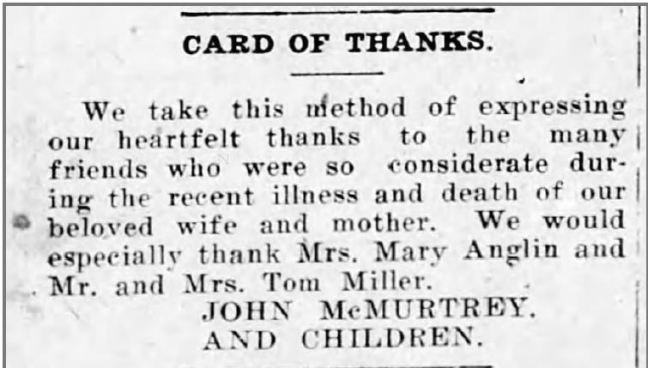

Irene Cox wanted nothing more than to have a family and live the predictable life of a homemaker. In 1901 at age 22, she married her step-father’s son Lora McMurtrey and they settled near Farris. Between 1902 and 1926 she and Lora had twelve children, but ending up losing six of them, including her firstborn.
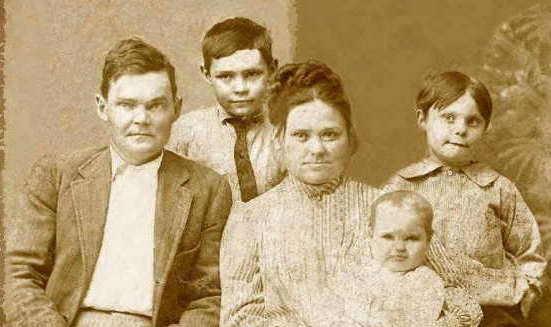
Here are a few recollections from her youngest daughter Mary Frances:
The McMurtrey home was rustic and simple. It had a large rock fireplace with a rough-hewn lumber mantel. On one side of the fireplace was a trunk where Irene kept some bed linens. In the kitchen was an oaken bucket with a copper ring around it to keep it together. Irene would scour the copper with ashes to make it shiny. Above the oak bucket, which was filled with water, was a gourd which the family would use to dip a drink of water.
Irene worked hard, raising her children, tending a vegetable garden, and feeding the chickens. She was a typical mom when it came to wanting her children to have nice things. Once her youngest son, Clyde gave her money to buy material to make a dress and instead of spending it on herself, she gave it to her daughter, Mary Frances, to buy clothes with.
Their social life was pretty limited to just visiting with neighbors. They didn’t attend church. A local minister used to come over and read the Bible but he had a crude habit of spitting tobacco juice in the fireplace and consequently Irene didn’t like him.
Evalena Frinzel kept house for her older brother John Frinzel until her brother married in 1923. In 1935 in the midst of the Great Depression, Evalena moved west to San Diego with her husband Thomas Inscore and daughter Mary, where Thomas became the proprietor of a grocery and Evalena was a dressmaker.
A half-brother Clyde McMurtrey followed the Inscores to California and found work as a mechanic. He passed away in 1947 from a perforated ulcer, leaving no known children.
The name Smallwood still resounds in certain parts of southeast Oklahoma. We have four daughters to thank for the continuing echoes and for the many descendants still here to remember their great family legacy.
We are indebted to Lee F. Harkins (1899-1957) of Tulsa, a great-grandson of Chief Smallwood, for much of the information we know about Chief Smallwood and his family.
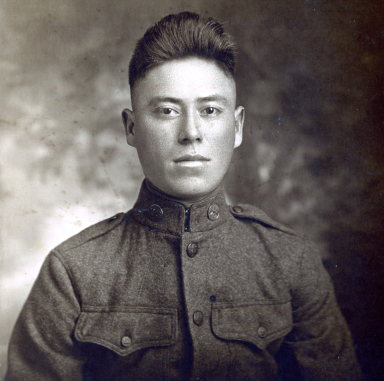

***YAHOKE, ikana! Thank you, friends. Much GRATITUDE for spending time on a Choctaw Journey with me.***
Please sign up on my blog page at WordPress to receive notifications by email (since Facebook notifications do not work well for this blog.)
SOURCES
“Chief Benjamin Franklin Smallwood,” The Chronicles of Oklahoma, Vol. 19, No. 3 (Sep 1941). page 213
Interview with Willie M. Griggs , Indian Pioneer Papers, Western History Collection, University of Oklahoma at Norman, 1937
Sketch of Charles Vinson, H. F. O’Beirne, Leaders and Leading Men, 1891, p. 146
Memorial Pages at Find-A-Grave:
- Benjamin Franklin Smallwood (1829-1891)
- Mary Jane Smallwood Griggs, died March 8, 1879
- Lorinda Smallwood James, 1849-1898
- Amelia Smallwood McMurtrey, 1858-1920
- Elmira Smallwood Cox, 1862-1887
Frinzel blacksmith advertisement, The Vindicator (Atoka, Oklahoma), Saturday, May 8, 1875, Page 4
Death of John Frinzell, Indian Citizen (Atoka, Indian Territory, Thursday, Dec 12, 1895, Page 5
Card of Thanks from John McMurtrey, Indian Citizen (Atoka, Oklahoma), Thursday, 23 Sep 1920, Page 1
Death of John McMurtrey, Johnston County Capital-Democrat (Tishomingo, Oklahoma), Thursday, Sep 7, 1922, Page 8


Eva Lena was my great grandmother, her son Fred my grandfather, Edith Frinzel my mother. Have been unable to find much info or pics of John Frinzel.
I know how frustrating that can be. Have you contacted the Atoka Museum at Atoka? 2902 North Highway 69, Atoka, OK 74525
580-889-7192 atokamuseum@yahoo.com
my name is Crystal (maiden name) James I’m starting my journey and found out that chief benjamin Smallwood is my great great great grandfather..lorinda Smallwood (James) is my great great great grandmother.. Charles (buck) James had a son his name is Charles Wendell James and he is my grandfather who had Charles Wendell James jr is my father. I don’t know much about this side of my family and I’m finding this very intriguing and interesting thank you all for the stories many blessings to all of you.